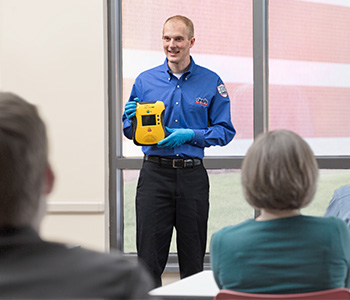Is CPR and AED Training Mandatory?

Like first aid training, CPR and AED training in the workplace saves thousands of lives each year. Many of the same federal rules apply to CPR and AED training as for first aid. But there are a few key differences.
What are the industry standards for AED and CPR training?
The federal government recommends, but does not mandate, that most workplaces have at least one person trained in the latest CPR techniques. Some higher-risk occupations, like construction and power transmission, are mandated to have trained and certified CPR and AED providers in the workplace. [1]
CPR and AED training isn’t mandated in every workplace, but is recommended by the federal government.[2] Some states and companies have their own compliance rules. [3]
On a federal level, OSHA (Occupational Safety & Health Agency), is responsible for enforcing and creating workplace safety standards in the U.S.
OSHA CPR/AED Training Regulations
Regulations for CPR and AED training are covered under the same rules as first aid training, according to OSHA.
On average, 2,150 Americans die of cardiovascular disease each day (an average of 1 death every 40 seconds). For each minute that a sudden cardiac arrest victim goes without CPR and defibrillation, their survival rate decreases by 10 percent, according to the American Heart Association. [4]
Who should have CPR/AED training?
OSHA 29 CFR 1910.151(b), says that “in the absence of an infirmary, clinic, or hospital in near proximity” to workplaces, employers shall have “a person or persons” trained to deliver First Aid.
Also, most states require CPR/AED training if you have an AED machine on site.
OSHA does not mandate that every workplace have at least one trained CPR or first aid provider, but strongly recommends it, the agency states in an interpretation letter. [5]
That same letter further explained that the recommendation applies to workplaces further than 3-4 minutes away from a healthcare center.
For the construction industry, OSHA 29 CFR 1926.50(c) provides:
In the absence of an infirmary clinic, hospital, or physician, that is reasonably accessible in terms of time and distance to the worksite, which is available for the treatment of injured employees, a person who has a valid certificate in first-aid training from the U.S. Bureau of Mines, the American Red Cross, or equivalent training that can be verified by documentary evidence, shall be available at the worksite to render first aid.
Do you have to be trained to perform CPR or use an AED?
You do not have to be certified to perform CPR, but training is recommended. Proper chest compression and rescue breathing should be practiced to help you deliver CPR properly. If these techniques are performed improperly, you could end up hurting the person you are trying to help.
The same goes for AED training. AED machines are designed to be easy to use, but do deliver an electric shock and should be used with proper care. AED training not only prepares you to deliver a heart shock, but also to recognize the signs of sudden cardiac arrest.
Should CPR/AED Training be Taught in Schools?
The issue of requiring CPR training in schools has been debated for years. There is no federal mandate for CPR training in schools. However, the trend across U.S. states is to mandate some sort of training and/or certification for teachers and students. A majority of states mandate student CPR training to graduate from high school. School CPR training often includes training to use an AED as well. [6]
There are specific CPR/AED courses for children, and for adults who work with children and infants. CPE/AED certification lasts for two years.
[1] https://www.shrm.org/resourcesandtools/tools-and-samples/how-to-guides/pages/determiningregulatoryrequirements.aspx
[2] https://www.osha.gov/laws-regs/standardinterpretations/2007-01-16-0
[3] http://etraintoday.com/blog/osha-federal-regulations-vs-individual-state-plans/
[4] http://www.heart.org/idc/groups/ahamah-public/@wcm/@sop/@smd/documents/downloadable/ucm_470704.pdf
[5] https://www.osha.gov/laws-regs/standardinterpretations/2007-01-16-0
[6] https://www.reuters.com/article/us-teens-cpr/many-u-s-schools-dont-teach-cpr-even-when-states-require-it-idUSKBN1DK2G7